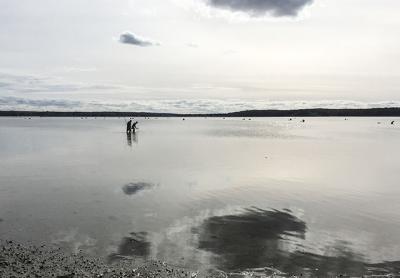Scallopers Rejoice as Season Opens

“We opened scallop season yesterday in town waters,” Francis Bock, clerk of the East Hampton Town Trustees, told his colleagues on Monday. “All the reports I've gotten are that it was very good.”
According to those in the know, the bay scallop population in town waterways, many of which are under trustee management on behalf of residents, has experienced a modest rebound after two consecutive years that were assessed as “not great,” “bleak,” “very bad,” and “horrible.”
While state waters opened to the harvesting of bay scallops on Nov. 6, the trustees set Sunday as the opening date for harvest in waters under their jurisdiction. Opening the season on a Sunday, when use of a dredge or other powered device is prohibited, gives everyone an opportunity to scoop some up, Mr. Bock said.
The town’s shellfish ordinance sets a daily limit of five bushels per day for holders of commercial permits; two or more such persons occupying the same boat may take in the aggregate up to 10 bushels per day. “Two or more persons, only one of whom holds a commercial permit and occupying the same boat while taking escallops, may take in the aggregate not more than five bushels in one day,” the ordinance reads.
All other permit holders are allowed one bushel per day, but if there ar more than three non-commericial permit holders on a boat, they can only take a total of three bushel per day.
“There was a solid abundance of mature scallops in Three Mile,” said Rick Drew, a deputy clerk of the trustees, who was at Three Mile Harbor on Sunday. “It was a great opening. A nice turnout by a lot of local folks. A lot of people got their recreational limit, commercial guys out there getting their limit. Marine Patrol was out checking licenses and takes. It was a nice community setting.”
In recent years, the hotly anticipated delicacy’s harvest has been affected by factors including blooms of cochlodinium, or rust tide. While not injurious to humans, rust tide can be harmful to shellfish and finfish. Predation by marine life, including crabs and conch, has also hurt, and is worsened by sparse habitat, such as eelgrass. Warmer water temperature may also be a culprit.
In this season’s early days, however, a number of baymen quickly reached the commercial limit. “Better than last year, a little bit,” was the positive but qualified assessment of Stuart Heath, a longtime bayman, speaking on Monday of Three Mile Harbor. Mr. Heath said he had filled five bushels by 11 a.m. that day, but “I don’t know how much it will hold up.”
“Pretty decent, but not tremendous,” was his prediction for the harvest. “The amount of guys thins out a bit” as the season progresses, “but guys that work on the water all winter will be able to work on it. There’s a nice healthy set, anyway. All nice, legal stuff — nice, plump meat, in state waters and Three Mile, too — and a few bugs for next year, though I don’t see a whole lot.”
Barley Dunne, director of the town’s shellfish hatchery, was less sanguine. The harvest, he said last week, “looks pretty reminiscent of last year. I know there’s one harbor in particular that looks pretty good — I don’t want to name it for fear of getting in trouble. The other harbors look pretty bleak.”
“I think most of the reason is there’s simply no habitat out there. There are scallops spawning and setting, and once they set to the bottom they’re being devoured,” Mr. Dunne said.
State waters, however, “do look pretty good,” he said. “There’s a lot of boats out there.”
The hatchery, which was established in the wake of algal blooms that decimated shellfish populations in the 1980s, seeds town waters with scallops, oysters, and clams.
The town must embark on “a big push” for habitat restoration, Mr. Dunne said, “whether it’s eelgrass or codium,” a seaweed also known as sputnik grass.
At Stuart’s Seafood Market in Amagansett, Charlotte Sasso said bay scallops were “plentiful this year.” As of yesterday, “it’s a good season,” and at $21.99 per pound the price is far below last year’s, when the supply was meager. “There’s a lot of demand locally,” Ms. Sasso said. “Everyone’s giving them to their relatives — Grandma comes first — and then they sell them.”
At the Seafood Shop in Wainscott, “Bay scallop season seems to be starting off quite well,” Colin Mather said last week. “As in most years, there seem to be a lot more coming in on the North Fork than the South Fork presently. . . . In any event, it’s much better than last year, and the price is down from last year at this time as a result of the quantity.” Bay scallops were priced at $20 per pound at the Seafood Shop, he said.
Anticipation this year ran as high as it always does, Ms. Sasso said. “For the month before the season opened, that was the question of the day: ‘When does scallop season open?’ ” she said. “The anticipation has been good for building up demand for them, they're more precious. Even though they may be a bit of a luxury item, they’re so satisfying. You don’t necessarily need a huge portion to have a very fulfilling, delicious dinner.”
